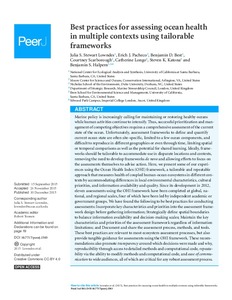| dc.contributor.author | Lowndes, Julia S.S. | |
| dc.contributor.author | Pacheco, Erich J. | |
| dc.contributor.author | Best, Benjamin D. | |
| dc.contributor.author | Scarborough, Courtney | |
| dc.contributor.author | Longo, Catherine | |
| dc.contributor.author | Katona, Steven K. | |
| dc.contributor.author | Halpern, Benjamin S. | |
| dc.date.accessioned | 2018-12-18T21:30:03Z | |
| dc.date.available | 2018-12-18T21:30:03Z | |
| dc.date.issued | 2015 | |
| dc.identifier.citation | Lowndes, J.S..; Pacheco, E.J.; Best, B.D., Scarborough, C.; Longo, C.; Katona, S.K. and Halpern, B.S. (2015) Best practices for assessing ocean health in multiple contexts using tailorable frameworks. PeerJ 3:e1503. DOI: https://doi.org/10.7717/peerj.1503 | en_US |
| dc.identifier.uri | http://hdl.handle.net/11329/602 | |
| dc.identifier.uri | http://dx.doi.org/10.25607/OBP-165 | |
| dc.description.abstract | Marine policy is increasingly calling for maintaining or restoring healthy oceans while human activities continue to intensify. Thus, successful prioritization and management of competing objectives requires a comprehensive assessment of the current state of the ocean. Unfortunately, assessment frameworks to define and quantify current ocean state are often site-specific, limited to a few ocean components, and difficult to reproduce in different geographies or even through time, limiting spatial or temporal comparisons as well as the potential for shared learning. Ideally, frameworks should be tailorable to accommodate use in disparate locations and contexts, removing the need to develop frameworks de novo and allowing efforts to focus on the assessments themselves to advise action. Here, we present some of our experiences using the Ocean Health Index (OHI) framework, a tailorable and repeatable approach that measures health of coupled human-ocean ecosystems in different contexts by accommodating differences in local environmental characteristics, cultural priorities, and information availability and quality. Since its development in 2012, eleven assessments using the OHI framework have been completed at global, national, and regional scales, four of which have been led by independent academic or government groups. We have found the following to be best practices for conducting assessments: Incorporate key characteristics and priorities into the assessment framework design before gathering information; Strategically define spatial boundaries to balance information availability and decision-making scales; Maintain the key characteristics and priorities of the assessment framework regardless of information limitations; and Document and share the assessment process, methods, and tools. These best practices are relevant to most ecosystem assessment processes, but also provide tangible guidance for assessments using the OHI framework. These recommendations also promote transparency around which decisions were made and why, reproducibility through access to detailed methods and computational code, repeatability via the ability to modify methods and computational code, and ease of communication to wide audiences, all of which are critical for any robust assessment process. | en_US |
| dc.language.iso | en | en_US |
| dc.rights | Attribution 4.0 | * |
| dc.rights.uri | http://creativecommons.org/licenses/by/4.0/ | * |
| dc.subject.other | Ocean Health Index (OHI) | en_US |
| dc.subject.other | Ecosystem assessment | en_US |
| dc.subject.other | Ecosystem-based management | en_US |
| dc.subject.other | Science policy | en_US |
| dc.title | Best practices for assessing ocean health in multiple contexts using tailorable frameworks. | en_US |
| dc.type | Journal Contribution | en_US |
| dc.description.refereed | Refereed | en_US |
| dc.identifier.doi | https://doi.org/10.7717/peerj.1503 | |
| dc.subject.parameterDiscipline | Parameter Discipline::Environment::Anthropogenic contamination | en_US |
| dc.bibliographicCitation.title | PeerJ | en_US |
| dc.bibliographicCitation.volume | 3 | en_US |
| dc.bibliographicCitation.issue | e1503 | en_US |
| dc.description.sdg | SDG14.1 | en_US |
| dc.description.bptype | Best Practice | en_US |
| dc.description.bptype | Guide | en_US |
| obps.contact.contactemail | lowndes@nceas.ucsb.edu | |
| obps.resourceurl.publisher | https://peerj.com/articles/1503/ | en_US |
 Repository of community practices in Ocean Research, Applications and Data/Information Management
Repository of community practices in Ocean Research, Applications and Data/Information Management

